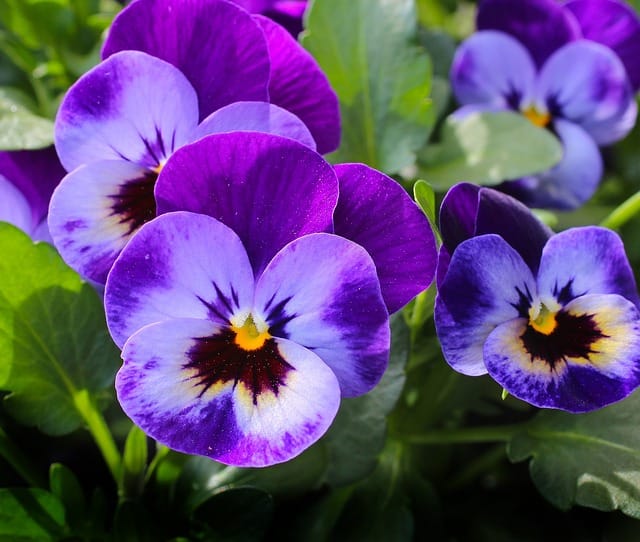How to grow Pansies
Pansies are beautiful and versatile flowers that are popular among gardeners

In this article:
- Introduction to Pansies
- Understanding Pansy Varieties
- Selecting the Right Location
- Preparing the Soil
- Planting Pansies
- Watering and Fertilizing
- Caring for Pansies
- Dealing with Common Pests and Diseases
- Propagating Pansies
- Extending the Pansy Growing Season
- Enjoying Pansies in Different Landscapes
- Pansies in Container Gardening
- Pansies in Hanging Baskets
- Pansy Companions and Planting Combinations
- Overwintering Pansies
- Conclusion
Introduction to Pansies
Pansies are beautiful and versatile flowers that are popular among gardeners. They come in a wide range of colors and their delicate petals add a touch of charm to any garden or landscape.
Understanding Pansy Varieties
Before you start growing pansies, it's essential to understand the different varieties available. There are single-flowered, double-flowered, and even ruffled pansy varieties. Each has its unique characteristics and growing requirements.
Selecting the Right Location
Pansies thrive in cool weather conditions, so it's important to choose a location that receives partial shade. Avoid areas with excessive heat or full sun exposure as it can hinder their growth and lead to wilting.
Preparing the Soil
Pansies prefer well-draining soil rich in organic matter. Prepare the soil by adding compost or well-rotted manure to improve its fertility and drainage. Remove any weeds or rocks from the area before planting.
Planting Pansies
Plant pansies in early spring or late fall for optimal growth. Dig holes that are slightly wider and deeper than the root ball of the pansy. Place the pansy plant in the hole and gently cover the roots with soil. Space the plants according to the recommended distance to ensure proper growth.
Watering and Fertilizing
Pansies require regular watering to keep their soil consistently moist, but not waterlogged. Avoid overwatering as it can lead to root rot. Fertilize pansies every few weeks with a balanced fertilizer to promote healthy growth and vibrant blooms.
Caring for Pansies
Regular care is essential for pansies to thrive. Remove faded flowers to encourage continuous blooming and prevent the plant from wasting energy on seed production. Monitor for any signs of pests or diseases and take necessary action promptly.
Dealing with Common Pests and Diseases
Pansies are susceptible to pests such as aphids, slugs, and snails. Use organic pest control methods or insecticides to keep these pests at bay. Diseases like powdery mildew and root rot can be prevented by providing good air circulation and avoiding overwatering.
Propagating Pansies
You can propagate pansies by collecting seeds or by taking cuttings from existing plants. Both methods require proper care and attention, but they offer an economical way to expand your pansy collection.
Extending the Pansy Growing Season
To enjoy pansies for a longer period, consider planting them in areas with cooler temperatures or providing shade during the hottest parts of the day. You can also use techniques like mulching to retain soil moisture and protect the plants.
Enjoying Pansies in Different Landscapes
Pansies can enhance the beauty of various landscapes. Whether you want to create a colorful border, a vibrant flower bed, or a charming cottage garden, pansies can be the perfect addition.
Pansies in Container Gardening
Pansies are excellent for container gardening as they are compact and can thrive in confined spaces. Choose a well-draining potting mix and ensure the container has proper drainage holes. Place the pots in areas with partial shade for optimal growth.
Pansies in Hanging Baskets
Hanging baskets filled with cascading pansies can add a stunning visual appeal to porches or balconies. Use lightweight potting soil for the baskets and ensure they receive enough water and fertilizer for healthy growth.
Pansy Companions and Planting Combinations
Pansies can be paired with various companion plants to create beautiful color combinations and textures in your garden. Consider planting them alongside tulips, daffodils, or violas for an eye-catching display.
Overwintering Pansies
In regions with mild winters, pansies can survive with proper protection. Mulch the plants with straw or leaves to insulate the roots and prevent frost damage. Ensure they receive enough moisture during the colder months.
Conclusion
Growing pansies can be a rewarding experience for any gardener. With the right care and attention, these charming flowers can thrive and provide continuous blooms throughout the growing season. Whether in gardens, containers, or hanging baskets, pansies bring a touch of beauty to any landscape.
